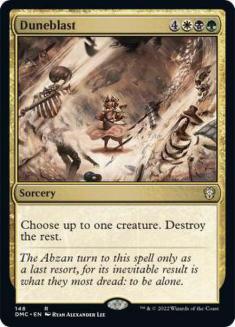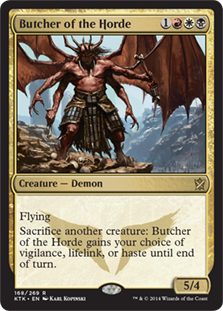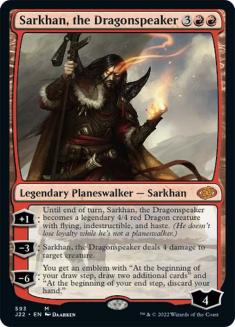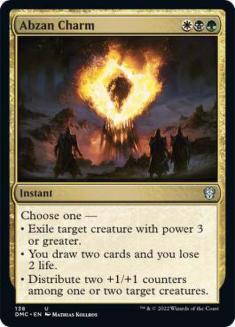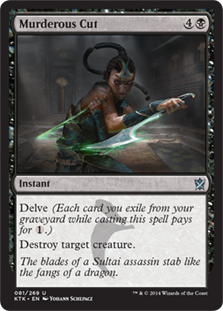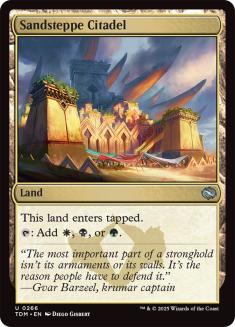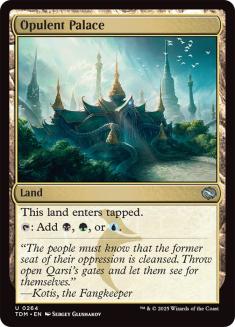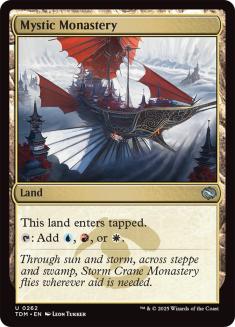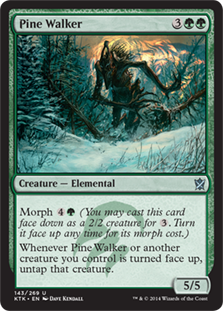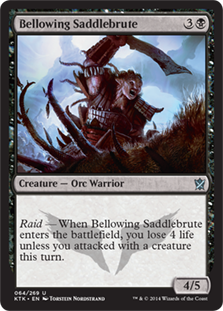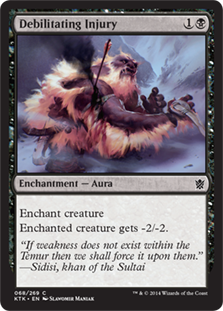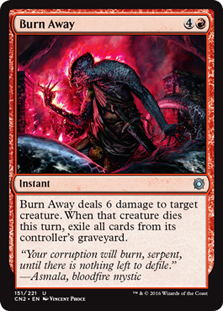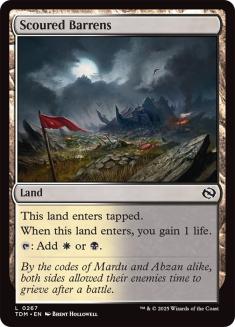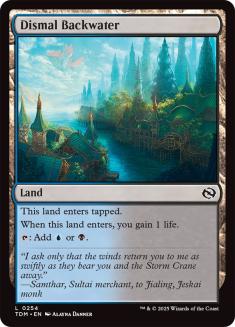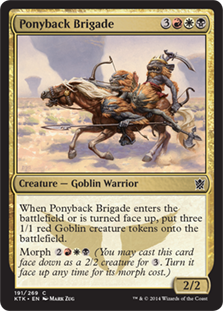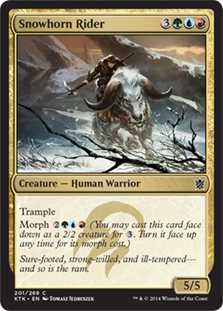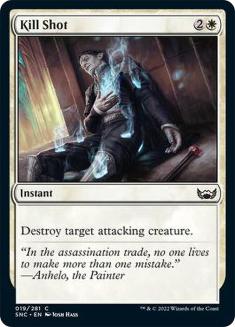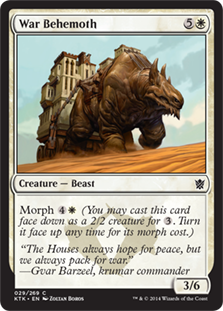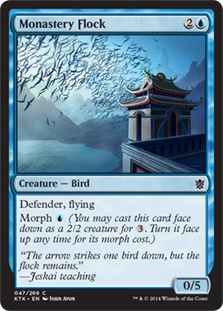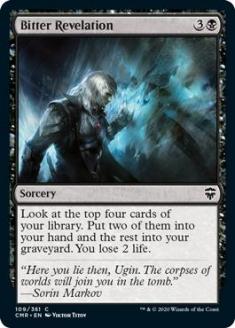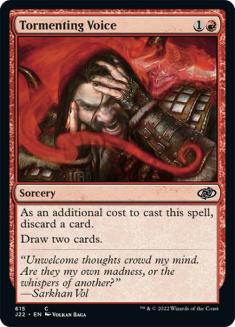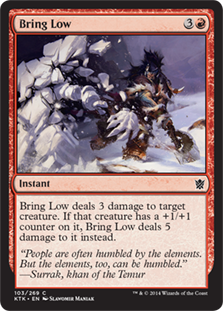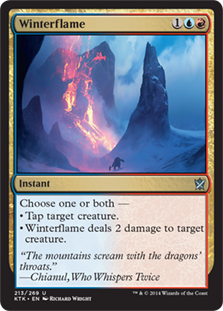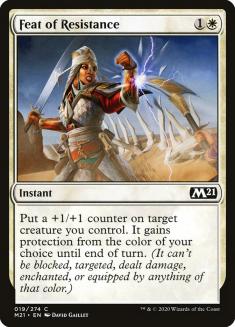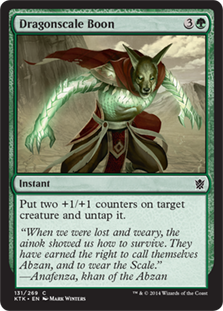Whenever someone asks about my Pro Tour Draft strategy, it’s always with an incredulous tone. “Why do you force Five-Color Morphs? It seems unreliable.” It
seems my team’s general success with the Five Color archetype has been hard for other people to replicate.
This is a general overview on how and why we did it.
Understanding the Decision
What incentives are there to draft Five Color in Khans?
The fixing in Khans of Tarkir is actually really poorly positioned for a three color deck. Rather than Shards of Alara, where the fixing was locked into
your three colors, the fixing is very modular. It also is randomly distributed.
This means that you can’t rely on seeing your specific on color fixing. Need a green land in Temur but get passed two Swiftwater Falls? Guess what, you now
have to play six Forests. You know what that means? You will draw three land hands that can’t cast your spells, be forced to keep them, and die. No one
wants that.
The base reaction to this would be to choose your clan heavily based on the fixing that arrives. It’s a fine plan, but it often leads to a few early picks
being thrown away. Of course, that’s just life when you draft reactively, and fixing coming around likely means that you will also be seeing cards of your
clan. Overall this plan isn’t bad, but it isn’t maximizing the potential of the format.
The second level reaction, which appears to be where most people were for the Pro Tour, was just ignore fixing as much as possible. The need to be three
colors in Khans is not nearly the same as the need to be three colors in Shards of Alara. Your multi-colored commons are morphs and inherently are “fixing”
by virtue of Grey Ogre mode. The uncommons and rares are great, but you won’t be saturated with them. There aren’t Kederekt Creepers or Steward of Valerons
that are consistently in packs and strain your mana early.
The goal for these drafters was to be a two color deck that might pick up a splash card and lands, play a manabase that is about 9/8/3 on color splits (or
even just the old 9/8), and play Magic while your opponents occasionally miss colors and die. Both halves of this naturally gravitate towards the beatdown
decks, and as such you saw U/G Morph Tempo, B/W Warriors, and various two color prowess decks in the spotlight very often.
Our team found another way to break the mold of the format and did so in a way that incidentally re-leveled the opposition.
If the big issue with moving into a trio based on fixing was that you would have to brick some great early picks, why not just draft to play all of those
cards? In fact, why not just draft to play anything? There are always great clan cards going around the table late because the Temur drafter is five seats
away from the person who opened Savage Knuckleblade and the U/R drafter between them is too busy taking Jeskai Windscouts to bother splashing. Why not just
be the person who ends up with all of those cards in their deck and beats their opponent by playing four rares in a game?
Drafting Five Color
It’s real easy. Here’s the pick order:
Bombs
Top Removal
Tri-Lands
Great Creatures
Above Average Removal
Dual Lands
Pretty Good Creatures
Generic Removal
Blockers, Random Finishers, and Morphs
Card Draw
Bad Removal
Combat Tricks
This certainly isn’t the acronym that BREAD is, but you take what you get.
You will notice there are two classes of cards above any lands.
Listen, you want lands in your deck so you can play the good cards. If you take lands over the good cards, you won’t have good cards to cast with them.
Take the good cards, then use all the lands to put them onto the stack. There are exceptions late in the draft where you know you need a land and have to
take it over a good spell. Earlier than mid-to-late pack two, this shouldn’t be the case.
The categories that brought the biggest debate in our team discussion were sorting between Bombs and Great Creatures. Do you take Ankle Shanker over
Sandsteppe Citadel? Armament Corps or Mystic Monastery? Frontier Bivouac or Abzan Falconer? (I make no promises these last two are actually print runs.)
The general answer we came to was that almost every five color deck was heavier in green, so if there was doubt as to which category the card was in, take
the tri-land if it is green and take the creature if the land is non-green.
The general framework you are aiming for with the above pick order is as follows. Keep in mind that there is always room to fudge a pick plus or minus a
slot or two in the order to meet some of these criteria, so Kill Shot over Efreet Weaponmaster when you have two removal cards in late pack two or
Abomination of Gudul over your eleventh non-basic is very realistic.
– 13 to 15 creatures. Being outside this range isn’t the worst, but there has to be reasons like, “I have a ton of spells that are too good to cut” or “I
have all the three color morphs and rare creatures.” Within creatures, there are a number of subcategories to satisfy:
· 1 to 4 of these creatures are good as heavily defensive options. Archers’ Parapet is the best example as it fills early curves nicely, but other examples
are Monastery Flock, Dragon Eye Savants, Sage-Eye Harrier, and even Rotting Mastodon (aka “Already dead, can’t die again in combat”). The more of these
cards you have that are morphs, the more you can afford to play total.
· You should have at least 2-3 ways to enter combat with a flying creature. Monastery Flock is, again, a good one, Longshot Squad is clunky but passable,
Sagu Archers and Sage-Eye Harrier are the typical options, and your own large fliers like Abomination of Gudul are best as they cover a lot of ground (or
more accurately air) in other categories.
· Three or so breakthrough threats that can win through a board stall. Again, see fliers like Abomination of Gudul. Most rares also fall here. Note that
sometimes a spell like Duneblast or Flying Crane Technique can cover for you here.
· Five or more three-drops including morphs. This is usually a non-issue because you just take a ton of morphs.
– 4 or so removal spells, hopefully of which three just kill whatever you need them to. Your goal is to exhaust your opponent’s best threats that trump
your average card quality then win the fight because your average cards smash theirs in the heads up. Things like Kill Shot or Rite of the Serpent go a
long way here. Note that the “kill anything” clause means that things like Mardu Charm and Bring Low that are less flexible are not as exciting as they
appear to be at first glance.
– At least two ways to draw or filter cards. You are typically playing longer games and need ways to continue to do things each turn. Even something as
unassuming as Bloodfire Mentor goes a long way to preventing long-term flood. Note that the morph incentive enchantments both do work here, especially
Secret Plans.
– The low pick order ranking for combat tricks is a result of the above. Feat of Resistance is an excellent card, as are Dragonscale Boon and Awaken the
Bear. You just need the interaction and card selection more. You are sacrificing speed for power in Five Color, and you need the cards that enable and
reward you for doing this. It’s not that you won’t play a Feat if you see one, it’s more that you don’t see them because they are less important for you to
grab than another card.
– 8 to 11 non-basic lands out of 18 total lands with a good spread across all of your colors. In a typical five color deck I have between four and seven
mana sources of each color, and just looking at raw numbers, the low end of that requires 7 duals in an 18 land deck. The spread is important because of
the basic land problem I mentioned earlier where you start having combinations of lands that just don’t cast anything. If you have more than 3 of any basic
land in your deck, something usually went wrong. Note that the 11 is actually a high end for tapped lands. If you have fetches go ahead and play more, but
at 6 or less basics you are just playing behind the curve every game and will just lose on the draw to “missing” your third and fifth land to a tapped
land.
Note that this all means you are playing at least 30 of your 42 picked cards, allowing you four or less blank picks per pack. That’s fine. Khans of Tarkir
is an exceptionally deep set and often you are presented with playables with two or three cards left in the pack, especially when every color is open to
you.
(Historical Note: This is why this strategy didn’t work nearly as well in Alara Block until Alara Reborn came out. Have you seen some of the cards in
Shards of Alara? After pick 8 you were lucky to get something better than a 23rd card, and you were better off just trying to make Onyx Goblet a playable.
Once Alara Reborn came out and you could count on 11 playables at least in pack three, it became right to just take the good cards and fixing and fill in
the deck with your last pack.)
Notes on Mana Production
Double-colored spells are relatively hard to cast. Not only does drawing the first source of a color reduce the odds of finding a second source of it, but
in terms of constructing your manabase and keeping hands, the double color overlap constricts your ability to cast other spells more than a tri-color card.
You are never obligated to play all five colors even if your general archetype is Five Color. If you don’t have a card you want to splash or can’t seem to
find a color in your lands, don’t commit to picking cards of that color later. Of course, you don’t need to have other cards of a color to splash something
that comes to you late, just the mana to actually cast it.
Morphs are easier to support on splashes than actual colored cards. This is obvious but is critical to understanding how the mana in these decks works and
why they shape up the way they do. Even something as unassuming as Sage-Eye Harrier makes the cut a lot more than you think it would because it is so
flexible and easy to slot into a curve.
Remember again: No more than three of any basic in an ideal world. Four is okay, but not the best. It bears repeating that this should drive later pick
land decisions.
A lot of my build decisions on mana are just based on years of feeling things out, but here are some loose guidelines:
– 3 sources: You have a card and a morph, or two cards.
– 4 sources: You have a couple (1-2) cards and a morph.
– 5 sources: You have a piece of removal you want to cast, a couple morphs, and maybe one other spell like a generic body or removal spell.
– 6 sources: You have multiple removal spells, a couple morphs, and a spell or maybe two. Alternatively, you don’t have a lot of the color but you have
some color-intensive rare like Wingmate Roc.
– 7 sources: More than six is the only good description I have. If you need more than seven of a color you are likely in a position where another color is
on 2-3 sources, if not just four color.
Creature Sizing
This is one of the most important principles of Five Color decks in Khans of Tarkir.
There is a lot of talk about Khans being defined by the three (cast) and five (flip) mana slots and the tempo around them.
That’s true, but that only holds for a small time frame each game. For the rest of the game it’s actually defined by sizing and blocking.
Just like Theros, X/5s rule the world. This is less because of removal lining up (see how Lash of the Whip and Rage of Purphoros worked against Nessian
Asp) and more because there just aren’t a lot of 5 power things to break the various X/5 walls. Monastery Flock, Archers’ Parapet, Sage-Eye Harrier, Sagu
Archers, and Glacial Stalker are some of the big names here. Of the creatures that can break through, you have mostly higher rarity cards and morphs that
trade down like Canyon Lurkers and Krumar Bond-Kin. Use removal on the first category, trade your other creatures for the other category.
This high toughness makes attacking cease to be profitable fast, and people just build up huge boards of creatures that don’t do anything. This is the game
your deck is trying to fight in by having the best creatures and spells to cast on these stalled boards.
This X/5 sizing makes a lot of the four-drops really bad. As I’ve mentioned before in Standard with respect to one drops last year, only having one turn
where your creature is good in combat after casting it is very bad at best. On the draw, there isn’t even a combat step before your opponent unmorphs
Glacial Stalker and your four mana 3/3 is a wasted investment. There are four-drops that can fight larger size battles, mostly due to outlast, but
Unyielding Krumar has no place here.
Larger ground monsters are also kind of a garbage plan as board stalls favor the double blocker. Woolly Loxodon is great as it is a morph that trumps all
the other morphs, but you can’t lean on it to run away with a game Dinosaur style as two 4/4s just jump in front of it.
So we have the basis for the evasion and flying blockers parts of the deck requirements. You need ways to win once you have established a locked board. You
need to assume other people will build to beat these board stalls and plan accordingly.
How do we get to these stalls we should be winning in? Trade. Trade liberally.
A payoff of the “lots of morphs as fixing and curve fillers plan” means that as we go later and draw more mana, our cards are just better than our
opponents. The easy way to lose to an aggressive deck is taking some damage, letting them get into position to make attacks as you start rectifying the
board, and then get blown out by a removal spell or trick. Who cares if their card is technically worse than yours? Exchange now and you will reach a board
state where all the things you cast outclass their things because they just cost more.
Note the above does not account for playing around pump. Don’t get Dragonscale Booned if you can’t handle it.
Also note that this principle of trading is a large part of why morph is so powerful. Morphs are something you can always do early, regardless of drawing
the right mana, and almost always trade away for anything that pressures you before turn 5. A lot of people hated on Trail of Mystery and Secret Plans, but
when you view them as things that make a large category of cards you already want to play even better and make trading very profitable, it’s obvious they
aren’t just gimmicks but instead actually good cards.
Keep in mind that it is always possible to turn the corner. The most obvious case is when you just cast some absurd rare and start shoving with it (see:
Savage Knuckleblade into Zurgo), but I’ve seen board states where sizing everywhere is at parity and someone is ahead on large creatures and can basically
force trades where they get in damage.
Minor Technical Play Notes
Know how to block around morphs. It’s basically a game of know what it can flip into and block accordingly, which is harder than it seems.
Life totals to preserve are typically measured in increments of Arrow Storm 5s. If you know they can double Lava Axe you out with that card, play around
it. If not, sometimes it happens to you.
Save removal to line up with the thing that is killing you. Making sure this is out there if it wasn’t extrapolated from the fact the format stalls, people
see a bunch of cards, and in general, the fact that multicolored formats tend to have lots of cards worth using removal on because they cost three colors
and have a gold or orange-purple symbol located in the middle of their right side.
Exit Strategies
Sometimes you just don’t see lands. It should be obvious by about pick six or so if things aren’t going to go your way, if not earlier.
You can be cut out of five color by other people aggressively picking fixing. If that happens, you need to know your ways out.
If you have a land or two before noticing, three colors is an option. Decide this based on the mana as always.
If not, all five enemy color pairs can support an aggressive deck. Some of the allied pairs even work in the same way. Find the open lane and move in.
Signals that White/X Aggro is open: Mardu Hordechief is the big one, but occasionally a Ride Down slips through.
Signals that Warriors is specifically open: Either Warrior Chief after pick two means you have some room to wiggle, as does Raiders’ Spoils after around
pick three.
That said, we had Warriors and White/X (or really Mardu in general) as trap decks. It’s really hard for these creatures to push through X/5s and you just
get bricked and die too often. Your spells that break through in white just don’t cut it against things with less than four power and high enough toughness
to live through a single +1/+1 counter.
There are times or ways to pick where you can have all the pieces, but it’s a very fine line between the 3-0 and 1-2 decks here.
Blue/X aggro is almost solely a game of find the Jeskai Windscout. As evidenced by Sol Malka’s 3-0 U/B draft from Grand Prix Orlando, you definitely aren’t
constricted to enemy colors once you find enough beatdown birds. Even white’s defensive or conditional removal is fine here because it lets you layer up on
prowess creatures and play that game. Mystic of the Hidden Way can play a similar role to Windscout, and your reward here for being in the archetype is
late pick bounce spells. Waterwhirl is an especially brutal card that people just don’t pick because it is double blue to cast.
Note that U/R is specifically a Prowess-Falter kind of deck and leans more on things like Barrage of Boulders and Crippling Chill to force in Canyon
Lurkers, Summit Prowler, and Whirlwind Adept. Basically, it’s building a ton of Lava Axes.
My favorite two color pair is green aggro. Similar to blue, you have room to play almost any pair except white, where the defensive removal spells again
are terrible. Red gives Arrow Storm, blue gives all the tempo cards, and black gives solid bodies and removal.
What does green give?
Pump spells and two-drops. Specifically, pump spells that matter and make your two-drops worth playing. Dragonscale Boon is a blowout if it connects, but
Awaken the Bear is almost equally as good. Note that the 2 power of a morph or two-drop plus the +3/+3 on Awaken the Bear is exactly the critical 5
toughness threshold of the format. Basically, green lets you lower your curve profitably without having to go all-in like other decks. Your secondary color
just provides more direct interaction like Singing Bell Strike, Arrow Storm, or Throttle along with off color bodies.
Just a reminder, all of these two color decks can be three colors, but it requires the mana. Don’t pick as if you will be three colors until you
have the mana to support it. I’ve passed Jeskai Charm in U/R pack three just because I didn’t have lands and didn’t want to assume I would find them.
The Context
Five Color is not necessarily the “best” archetype by a number of metrics. It certainly doesn’t produce the most 9’s or 10’s (that would be B/W Warriors at
the cost of producing a lot of 3’s and 4’s). It isn’t always available.
So why is it the default Draft archetype?
What drafting the Five Color style results in is the most consistent plan. Your early picks allow you to just take the best cards that come to you, and if
you see the lands your deck is typically a solid 7 or 8.
Again, the Five Color archetype also fundamentally matches the fixing in the format as I mentioned up front.
Finally, it perfectly matches the card power level in Khans. The set is deep, so you don’t want to commit early as moving into the open colors and getting
strong playables later than you should in later packs rewards you greatly, but the high end of the set is super powerful, so abandoning your first pick has
real cost. Drafting all the colors lets you have your cake and eat it too.
So, the real answer to why I draft or force Five Color?
“I don’t force it, I draft the set the way the cards tell me to.”

